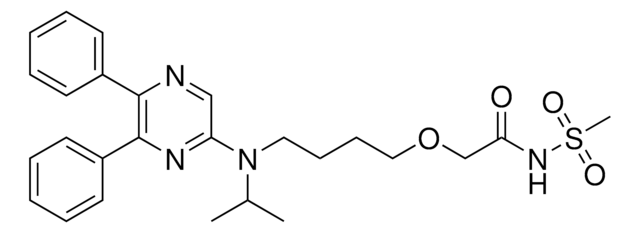SRP3147
Relaxin-2 Peptide
≥98% (HPLC), human recombinant, expressed in E. coli, suitable for cell culture
Synonym(e):
H2 relaxin, RLN2
Anmeldenzur Ansicht organisationsspezifischer und vertraglich vereinbarter Preise
Alle Fotos(1)
About This Item
UNSPSC-Code:
12352202
NACRES:
NA.32
Empfohlene Produkte
Produktbezeichnung
Relaxin-2 human, recombinant, expressed in E. coli, ≥98% (SDS-PAGE), ≥98% (HPLC), suitable for cell culture
Biologische Quelle
human
Rekombinant
expressed in E. coli
Assay
≥98% (HPLC)
≥98% (SDS-PAGE)
Form
lyophilized
Mol-Gew.
6.0 kDa
Verpackung
pkg of 25 μg
Methode(n)
cell culture | mammalian: suitable
Verunreinigungen
<0.1 EU/μg endotoxin, tested
Farbe
white
UniProt-Hinterlegungsnummer
Versandbedingung
wet ice
Lagertemp.
−20°C
Angaben zum Gen
human ... RLN2(6019)
Verwandte Kategorien
Allgemeine Beschreibung
Relaxin-2 is a peptide hormone structurally related to insulin. The gene is mapped to human chromosome 9p24. It is expressed in the placenta, decidua, prostate, corpus luteum, endometrium, mammary glands, heart, and brain. It is also expressed in the ovary during pregnancy. Recombinant relaxin-2 is a nonglycosylated 6kDa disulfide linked heterodimeric protein consisting of a 24 amino acid A-chain and a 29 amino acid B-chain.
Anwendung
It has also been used to study its effect on human endometrial carcinoma cell lines.
Relaxin-2 human has been used to study the effect of testosterone on the expression of relaxin receptor in the knee joint.
Biochem./physiol. Wirkung
Of the three known relaxin genes, Relaxin-2 (RLN2) is the only relaxin known to circulate in the blood. Relaxin-2 binds specifically to the LGR7 (leucine-rich repeat-containing G-protein coupled receptor 7) and LGR8 receptors, previously identified as an "orphan" G protein coupled receptors. Signaling by Relaxin-2 through its target receptors enhances the growth of pubic ligaments and ripening of the cervix during birth. Relaxin-2 also participates in cancer progression. In prostate cancer, it is responsible for tumor growth and vascularisation. Relaxin-2 is also linked with anti-fibrotic and cardioprotective effects.
Sequenz
A-Chain: QLYSALANKC CHVGCTKRSL ARFC B-Chain: DSWMEEVIKL CGRELVRAQI AICGMSTWS
Physikalische Form
Lyophilized with no additives.
Rekonstituierung
Centrifuge the vial prior to opening. Reconstitute in water to a concentration of 0.1-1.0 mg/ml. Do not vortex. This solution can be stored at 2-8°C for up to 1 week. For extended storage, it is recommended to further dilute in a buffer containing a carrier protein (example 0.1% BSA) and store in working aliquots at -20°C to -80°C.
Lagerklassenschlüssel
11 - Combustible Solids
WGK
WGK 3
Flammpunkt (°F)
Not applicable
Flammpunkt (°C)
Not applicable
Hier finden Sie alle aktuellen Versionen:
Besitzen Sie dieses Produkt bereits?
In der Dokumentenbibliothek finden Sie die Dokumentation zu den Produkten, die Sie kürzlich erworben haben.
The complex binding mode of the peptide hormone H2 relaxin to its receptor RXFP1.
Sethi A, et al.
Nature Communications, 7, 11344-11344 (2016)
Evolution of the relaxin/insulin-like gene family in anthropoid primates.
Arroyo JI, et al.
Genome Biology and Evolution, 6, 491-499 (2014)
Dual blockade of PKA and NF-?B inhibits H2 relaxin-mediated castrate-resistant growth of prostate cancer sublines and induces apoptosis.
Vinall RL, et al.
Hormones & Cancer, 2, 224-238 (2011)
Human relaxin-2: historical perspectives and role in cancer biology.
Nair VB, et al.
Amino Acids, 43, 1131-1140 (2012)
Analysis of the 5'-upstream regions of the human relaxin H1 and H2 genes and their chromosomal localization on chromosome 9p24.1 by radiation hybrid and breakpoint mapping.
Garibay-Tupas JL, et al.
Journal of Molecular Endocrinology, 23, 355-365 (1999)
Unser Team von Wissenschaftlern verfügt über Erfahrung in allen Forschungsbereichen einschließlich Life Science, Materialwissenschaften, chemischer Synthese, Chromatographie, Analytik und vielen mehr..
Setzen Sie sich mit dem technischen Dienst in Verbindung.






